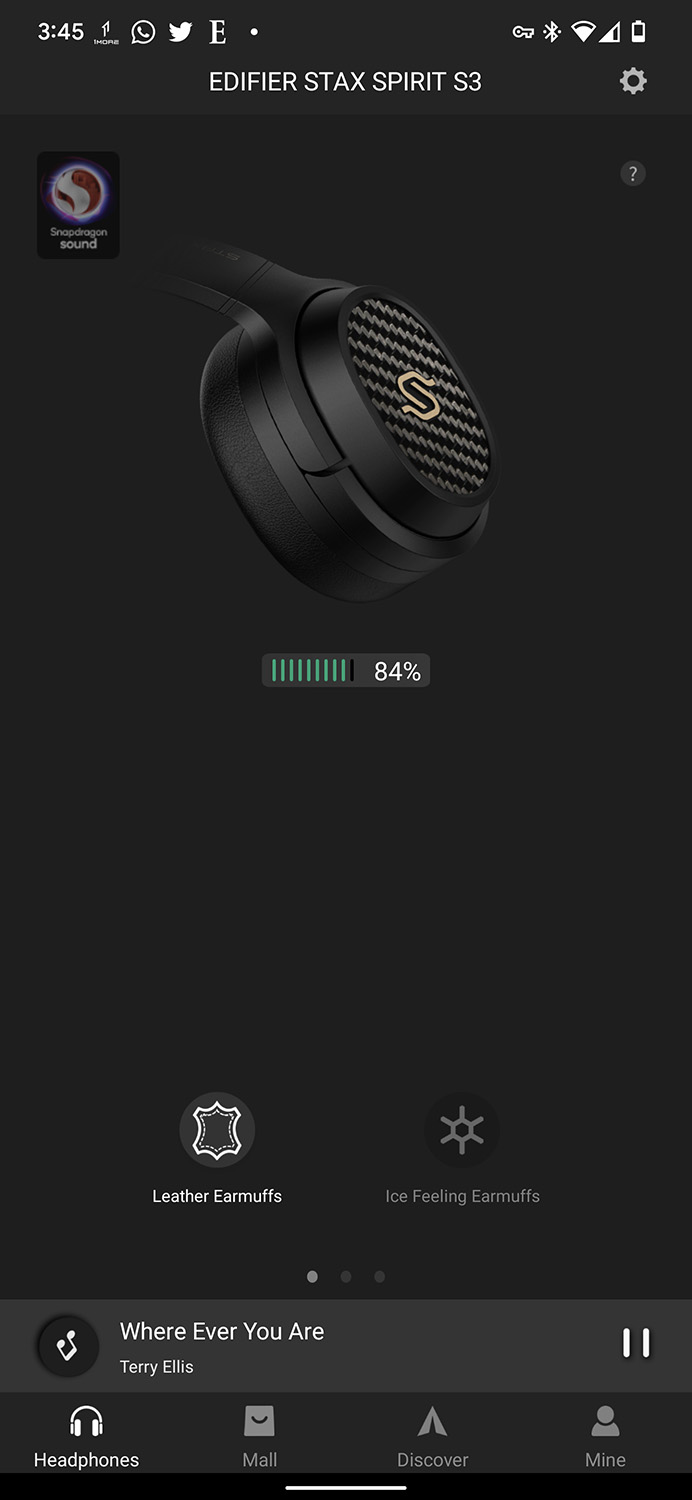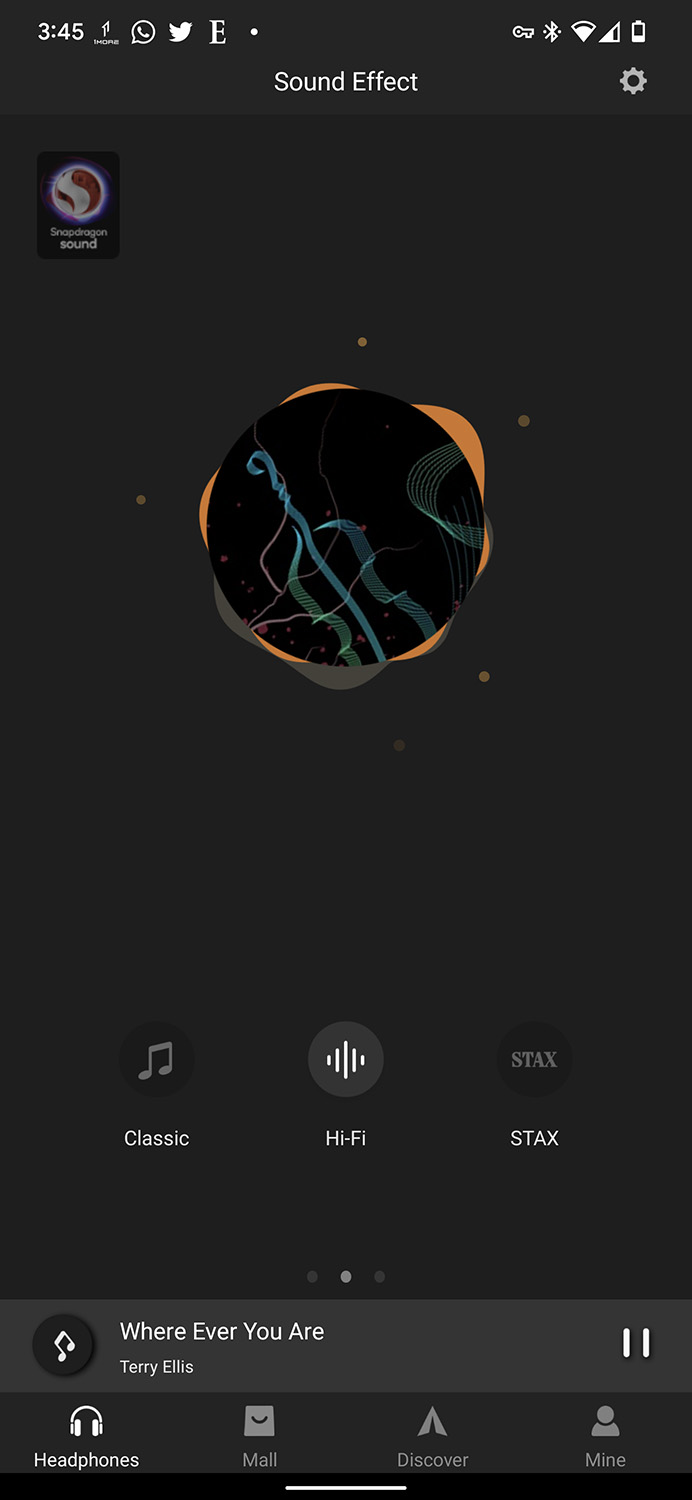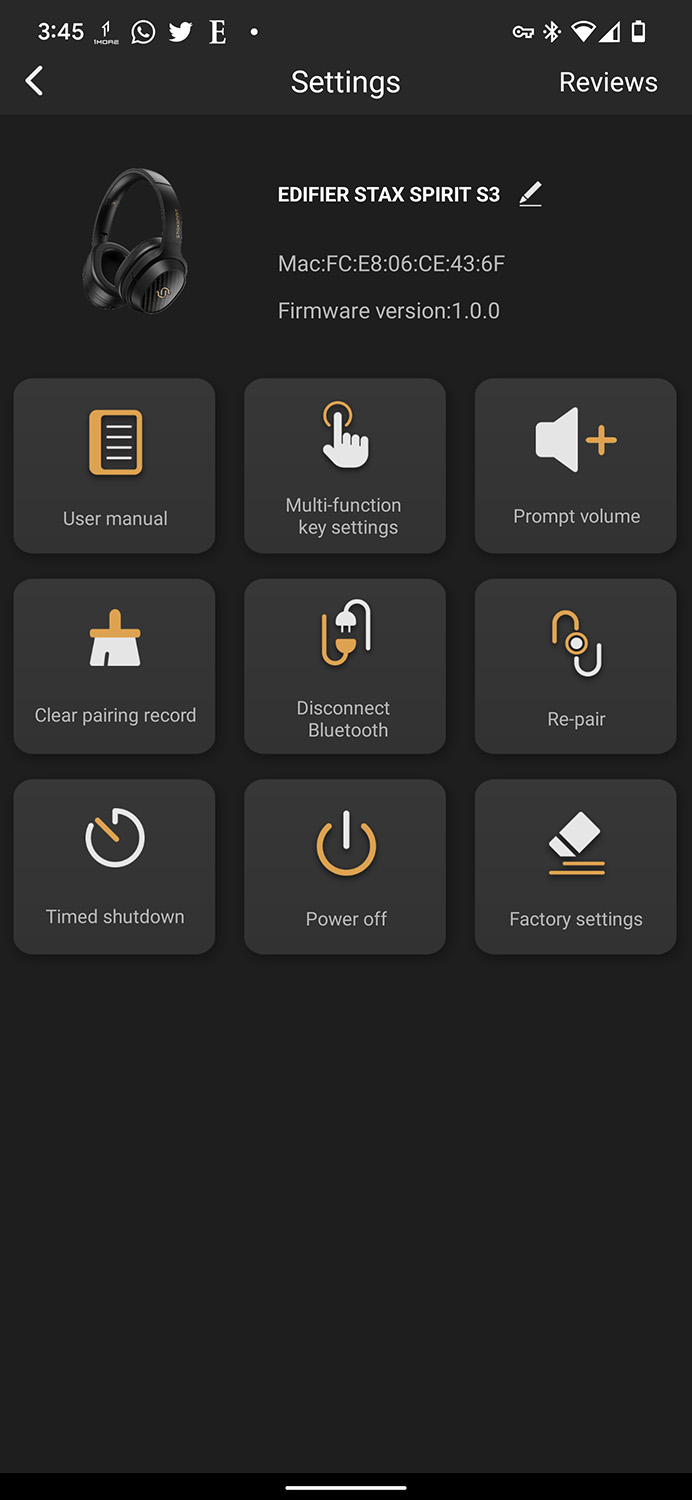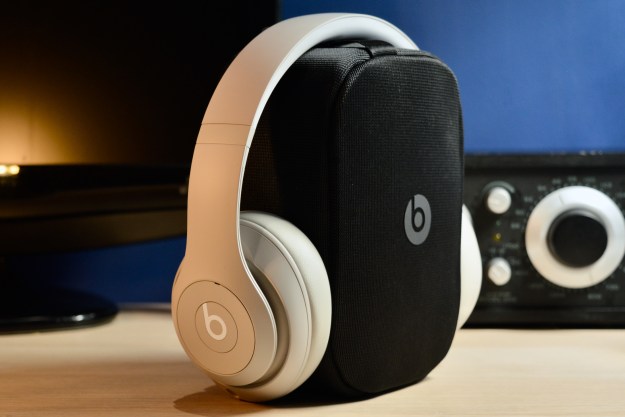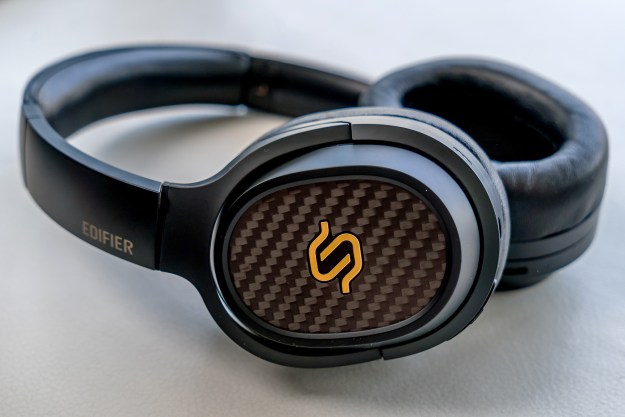
- Excellent sound quality
- Very comfy fit
- Two sets of ear cushions
- Solid call quality
- Outstanding battery life
- Great app support
- No ANC or ambient mode
- No EQ in app
- Volume levels low in wired mode
Planar magnetic headphones aren’t new, but due to the technology’s relatively high price and relatively large size, it’s been relegated to the upper echelon of the headphone market, where those with enough money to afford them (and an audiophile sensibility to appreciate them) have been the only buyers. But planar’s benefits — smoother, more detailed sound, with noticeably less distortion — can be enjoyed by anyone.
That very much describes what Edifier looks to achieve with the $400 Stax Spirit S3 — a set of wireless planar magnetic cans that are designed to be light enough, comfy enough, portable enough (and critically, affordable enough) to be considered an everyday option. For a brand not necessarily known for its overall sonic prowess, can Edifier pull off a spirited surprise, or are they Stax Spirit S3 more planar hype than anything else? Let’s take a listen to find out.
What’s in the box
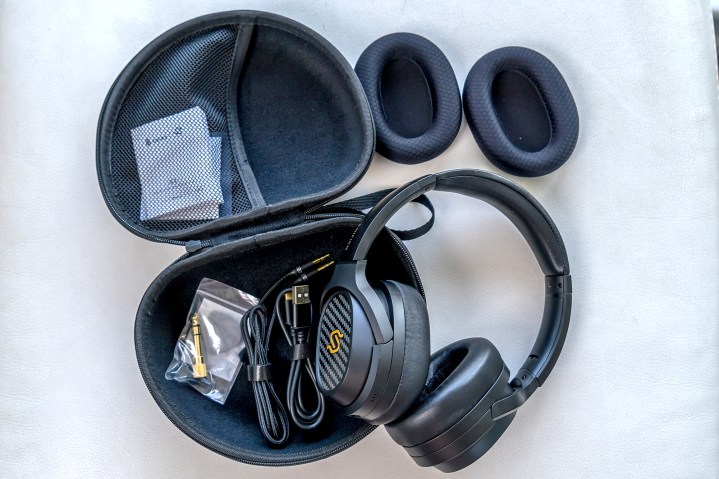
There isn’t anything overtly different about the packaging, though Edifier does go the elegant route with a slick look. In the box with the headphones, you get a nice clamshell case. Open that up, and the pouch on the top half holds the 3.5mm cable, 1/4-inch adapter, USB-C charging cable, and quick start manual. Along with the standard leather ear cups, you get an extra pair Edifier calls “Ice Feeling” because of their fabric lining that feels cooler over longer listening stretches.
Design
Planar magnetic headphones are usually a little bigger to accommodate the tech necessary to make them what they are. They may be a bit thick, but I found the Stax Spirit S3 to be on par with any other pair of cans using dynamic drivers. Cushioning is great with both sets of ear cups, something I noticed when I wore them for hours while working. I barely felt any discomfort, and while I know everyone’s ears are different, odds are good you may find they do the same for you, too.
The Stax Spirit S3 are one of the best over-ear cans I’ve tested in a long while.
In terms of controls, you get everything you need from the combo multifunction/volume buttons on the right ear cup. Track skipping is done via the volume buttons, while call answer/end and Bluetooth pairing are done with the multifunction button. But that button also gives you additional choices via the Edifier app. By default, a single click performs play/pause, but there are also double- and triple-click commands too. These can be set to one of: Play/pause (not sure why that’s there again), voice assistant, game mode, and switching between the three EQ/sound effects: Classic, Hi-Fi, and Stax. Unfortunately, there are no wear sensors, so take these off, and they keep on playing.
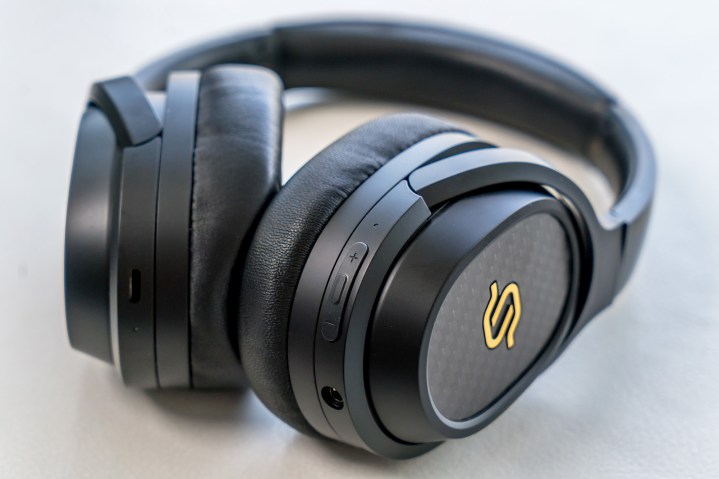
These are Bluetooth headphones, and work just as well in a wired capacity. The only catch is that you need to use the battery in both cases, as they can’t work in a passive state, again due to the planar magnetic design.
What’s missing is active noise cancelation (ANC) and an ambient mode, leaving the onboard mic to focus almost exclusively on phone calls and voice assistant access. Passive isolation is excellent, so you will at least drown out some of the background, but if you are looking for ANC, you’ll have to find it elsewhere.
Instead, the focus here is on hi-res audio by way of aptX Adaptive codec support to go with SBC and AAC. No LDAC or LHDC, so no other hi-res codecs here. Edifier plays up Snapdragon Sound through the Qualcomm Bluetooth chipset going up to 24-bit/96kHz support, which certainly qualifies as wireless hi-res, though you will need the playback device to also support aptX Adaptive to benefit from the fidelity. The Snapdragon Sound logo appears no matter what phone you’re using, even if it doesn’t support the feature, so don’t assume it’s active when it’s not. Alternatively, you can also listen through a wired connection, especially if you have a DAC (digital-to-analog converter) that does the heavy lifting.
Planar details
So why is planar magnetic a big deal? The planar magnetic diaphragms generate sound waves in ways that lessen distortion, and that’s a big reason why the sound comes through more balanced, and especially resonant in the mid-range. What makes them sonic stalwarts is the way they use a thin diaphragm between magnets to create vibrant sounds with less distortion. Dynamic drivers, which are in an overwhelming majority of headphones, use a magnet wrapped in a coil that can create deeper sounds, but they also tend to hit some distortion at higher volumes. Edifier licensed some of what it needed to make the Stax Spirit S3 from Audeze, a company that has become synonymous with planar magnetic in recent years. It’s a combination that works.
There were subtleties that came out with a number of tracks that I felt underpinned the strengths of these headphones.
Edifier’s big contribution to the planar field started with its acquisition of Stax, a maker of electrostatic headphones, in 2011. Though it clearly took some time for Edifier to focus that team, the result is the Stax Spirit S3, a set of wireless planar cans that are only a hair bigger and heavier than non-planar headphones. It only takes one look at the ginormous Monoprice M1070C to realize just what an achievement this is — and the M1070C aren’t even wireless. I would just be cautious of the bold claims Edifier makes when it comes to performance, including for phone calls, which it says uses the “most advanced micro processing system,” asserting that calls will sound like face-to-face communication.
They’re really good, no question, but not quite at the lofty measure such a sentiment suggests. The confidence extends to overall sound quality, calling out the various components used to manufacture the Stax Spirit S3.
Using the Edifier app
Edifier’s app now has a section specifically for Stax Spirit headphones, and the needless Snapdragon Sound branding notwithstanding, it’s easy enough to get around. What I would’ve preferred is that the company go easy on the upselling, as it shamelessly allocates two sections on the menu at the bottom to hawking more of its products. I have no issue with a company promoting its own stuff, but when you bury the settings and ancillary features for the headphones into the top right corner, it can lead to confusion. It might’ve been better to put the settings in the menu, and then put the Mail and Discover sections within that.
At any rate, there are a few things to customize. First, are the earmuffs you choose to use. The main screen will let you select the ones you’re wearing so the app can make some adjustments to the sound profile. Swipe left and you see the three sound effects (Classic, Hi-Fi, Stax) I previously noted. What’s puzzling is that Edifier saw to it to include a brief explainer about the earmuffs, yet chose not to for the sound effects. Perhaps it thinks people buying these headphones would already know, but educating a consumer is not a bad idea in cases like this. Swipe left again and you get to Game Mode, which is off by default. Turn it on, and the Stax Spirit S3 cut down latency, something I found also worked well while watching a show or movie by adeptly syncing audio and video.
The other settings are largely functional, such as setting the button controls, setting a timer for the headphones to turn off, clearing them of all paired devices, or restoring to factory settings.
Sound quality

The Stax Spirit S3 are one of the best over-ear cans I’ve tested in a long while. They sound great out of the box, and I was struck by the level of detail available in a wide variety of tracks. Most headphones will prioritize bass with treble to make use of the strengths dynamic drivers can deliver on the low end, but planar cans like this really make the mids come to life.
I played around extensively with the three sound effects, and concluded that Classic offers more on the low end, Hi-Fi delivers the best mids, while Stax clears up the treble, albeit at the expense of the lows. I didn’t use Stax as much as the other two for that reason. I listened to a lot of tracks in Hi-Fi or Master on Tidal, as well as the best that Spotify could currently do to ascertain any differences. I also tried FLAC files on a wired connection with a DAC through Plex to gauge performance that way, too.
“You’re on headphones? I thought you were talking into your phone.”
There were subtleties that came out with a number of tracks that I felt underpinned the strengths of these headphones. The piano and bass guitar riff in Change’s A Lovers Holiday had some extra polish I hadn’t really noticed before. This became a common theme, where instrumentation resonated across a variety of tracks and genres. When I played a Master of something as old as Bad Moon Rising by Creedance Clearwater Revival, the song came alive in Hi-Fi mode, with each guitar breathing life into the song.
Sade’s Maureen and Lovers Rock allowed her soulful voice to really carry through, and it was a pleasure to listen to the band’s albums with the Stax Spirit S3. Even trying modern tracks, like Banking on Me by Gunna or Heat Waves by Glass Animals showed that detail isn’t exclusive to one era or another.

If you’re a stickler for bass, you may lament that it’s not as punchy here, but that’s kind of the point. Classic and Hi-Fi still provide a good amount, though hardly what I would consider a rumbling effect. They aren’t going to match what Sony can deliver with the WH-1000XM5, or even a good pair of Bang & Olufsens or Bowers & Wilkins. It’s one reason why I wish Edifier included a 10-band EQ into the app to tailor the sound just enough to bring in a little more bass for those who want it.
I would also point out that iOS and Android experiences may differ, simply because the latter tends to support aptX. Not every phone can do aptX HD or aptX Adaptive, and that does matter if you want the highest possible quality. Tidal and Amazon Music HD on a compatible phone could bring out just that little extra in a song, much like I described above. Even so, I was struck by how good the Stax Spirit S3 sounded with phones like the Pixel 6 Pro and iPhone 13 when paired with them.
Button controls were fine, limited as they were. Phone calls were also excellent, and I knew it when a caller said, “You’re on headphones? I thought you were talking into your phone.” Callers could hear me clearly, especially in quieter settings, whereas anywhere with a crowd or background noise might pose a challenge because there’s nothing to cancel it out. Edifier says it uses aptX Voice technology to achieve all that, which is basically a separate codec that’s part of certain Snapdragon chipsets to focus on voice clarity independent of that for music streaming. It just can’t do anything to drown out background noise.
What’s also great is the headphones support multipoint connections, letting you pair them with two devices simultaneously. Super convenient if you listen to music from your computer but always want to stay in touch in case a call comes in on your phone. It’s a pretty seamless transition, as just answering the call switches over. End the call, start up the music again on your computer, and you’re back there again.
Battery life

The Stax Spirit S3 are a horse on battery life. They just keep running and running. Edifier rates them at up to 80 hours per charge, which is ridiculous in a good way, and while that number can fluctuate based on volume level, I can attest that you won’t be charging them too often. Out of my own curiosity, I paired them with an iPhone I had laying around and looped a Hi-Fi playlist on Tidal, leaving them to play uninterrupted overnight at roughly 60% volume. When I checked about seven hours later, they had only lost 15% battery life.
It’s an important piece of this puzzle because the battery always has to be on. I mentioned earlier that you need to power on to listen in wired mode, but my real gripe with that was how low the volume was by default. I had to routinely leave it cranked up to 90-100% to hear what I would normally hear over Bluetooth at 50-60%.
On the bright side, the headphones do have fast charging, so plugging in for 10 minutes can get you up to 11 hours of listening time. More than enough for most long-haul flights if you plan to travel with these wrapped around your head.
Our take
Credit to Edifier for crafting an impressive pair of planar magnetic cans. They not only feel really comfortable, but are almost revelatory in how good they sound. I readily admit I was surprised at their fidelity and consistency, and I imagine you might be as well whether or not you’re familiar with the brand and its products. And while the price tag might seem high when compared to other wireless cans, for those in search of supreme sound quality, they’re a bargain.
Is there a better alternative?
Sony’s WH-1000XM5 are a benchmark for over-ear headphones, and with good reason. They not only carry on a fabulous legacy, but also offer a load of features to go with the fact you don’t need to power them on to listen with a wired connection. You don’t get planar magnetic tech with them, but they are wireless and highly capable of producing outstanding sound using dynamic drivers.
If you’re enticed by the idea of planar headphones, it doesn’t get much better than the wired, open-back, $899 Audeze LCD-2. They’re far more expensive, and lack the convenience and sound isolation of the Stax Spirit S2, but the LCD-2 are super acclaimed by planar-loving audiophiles.
On the other hand, if you’re looking for an affordable yet reference-quality listening experience (and you’re good with open-back designs), the Sennheiser HD 560S don’t have planar magnetic tech inside, but you may not notice the difference.
How long will they last?
Take care of them, and they’ll take care of you. The Stax Spirit S3 will last as long as the battery can take you, and that seems to be a long time based on how long each charge lasts. These aren’t ideal for working out, so consider them for leisurely pursuits above all else. Edifier offers a standard one-year warranty for functional problems, but not physical damage.
Should you buy them?
Absolutely. If you want balanced sound and like to hear it with different genres of music, you won’t go wrong trying the Stax Spirit S3 on for size. Your ears will also probably thank you for the comfort they bring. The price is right for what you get here, considering what’s happening inside.

